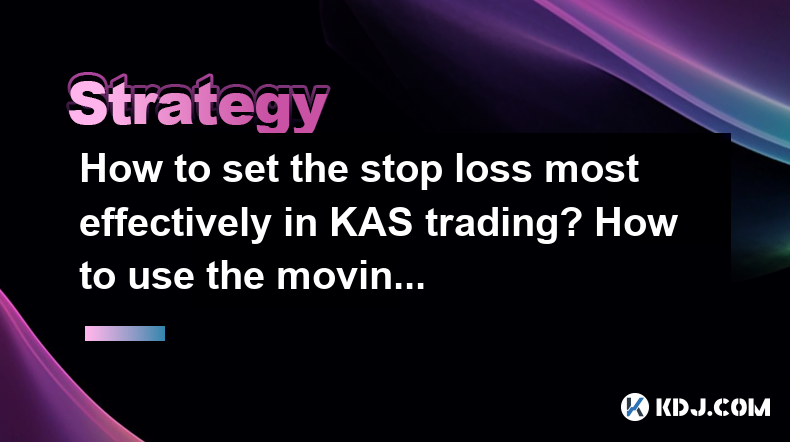-
 bitcoin
bitcoin $114684.631706 USD
-0.87% -
 ethereum
ethereum $4228.677447 USD
1.58% -
 bnb
bnb $1294.880693 USD
-1.16% -
 tether
tether $1.000819 USD
-0.02% -
 xrp
xrp $2.605138 USD
2.79% -
 solana
solana $209.908690 USD
5.89% -
 usd-coin
usd-coin $0.999903 USD
-0.03% -
 dogecoin
dogecoin $0.213423 USD
2.93% -
 tron
tron $0.322721 USD
-0.10% -
 cardano
cardano $0.727247 USD
3.66% -
 hyperliquid
hyperliquid $42.339456 USD
6.05% -
 chainlink
chainlink $19.910811 USD
5.16% -
 ethena-usde
ethena-usde $1.000557 USD
0.00% -
 stellar
stellar $0.349734 USD
2.69% -
 bitcoin-cash
bitcoin-cash $543.848687 USD
-0.21%
How to set the stop loss most effectively in KAS trading? How to use the moving stop loss?
To optimize KAS trading, set a stop loss based on volatility and risk tolerance, and use a moving stop loss to lock in profits as the price rises.
May 02, 2025 at 11:56 am

Trading cryptocurrencies like Kaspa (KAS) can be an exciting yet risky endeavor. One of the most critical aspects of managing risk in trading is setting an effective stop loss. A stop loss order helps you limit potential losses by automatically selling your asset when its price reaches a certain level. In this article, we will delve into how to set the stop loss most effectively in KAS trading and how to use the moving stop loss, providing you with detailed steps and strategies to optimize your trading experience.
Understanding Stop Loss in KAS Trading
A stop loss is a crucial tool for any trader, especially in the volatile world of cryptocurrencies. It's designed to prevent significant losses by exiting a trade when the market moves against your position. For KAS trading, setting a stop loss involves deciding at what price you are willing to sell your KAS to cut your losses.
To set a stop loss in KAS trading, you typically follow these steps:
- Choose your trading platform: Ensure that your chosen platform supports stop loss orders.
- Determine your stop loss level: Based on your risk tolerance and market analysis, decide at what price you want your stop loss to trigger.
- Place the order: On your trading platform, enter the stop loss order specifying the price at which you want to sell your KAS.
Factors to Consider When Setting a Stop Loss
When setting a stop loss for KAS trading, several factors need to be considered to ensure it's as effective as possible.
- Volatility: KAS, like many cryptocurrencies, can be highly volatile. Setting a stop loss too close to the current price might result in the trade being triggered by normal market fluctuations rather than a significant downturn.
- Technical Analysis: Use tools like support and resistance levels, trend lines, and chart patterns to identify logical points for your stop loss.
- Risk Management: Decide how much of your trading capital you are willing to risk on a single trade. A common rule of thumb is to risk no more than 1-2% of your total trading capital on any single trade.
Implementing a Moving Stop Loss in KAS Trading
A moving stop loss, also known as a trailing stop loss, is a dynamic type of stop loss that adjusts as the price of the asset moves in your favor. This can help you lock in profits while still protecting against significant losses.
To use a moving stop loss in KAS trading, follow these steps:
- Set the initial stop loss: Start by setting a traditional stop loss order at a fixed price.
- Determine the trailing amount: Decide on a percentage or fixed amount by which the stop loss will trail the market price.
- Monitor and adjust: As the price of KAS moves in your favor, the stop loss will automatically adjust to maintain the set distance from the current market price.
Advantages of Using a Moving Stop Loss in KAS Trading
Using a moving stop loss in KAS trading offers several advantages:
- Locking in Profits: As the price of KAS increases, the moving stop loss adjusts upwards, allowing you to secure gains without manually adjusting the stop loss.
- Flexibility: It provides a more dynamic approach to risk management, adapting to market movements.
- Protection Against Reversals: If the market suddenly turns against you, the moving stop loss can help minimize losses by exiting the trade at a more favorable price than a static stop loss.
Practical Example of Setting a Moving Stop Loss for KAS
Let's walk through a practical example of setting a moving stop loss for KAS trading.
- Initial Purchase: Suppose you buy KAS at $0.10 per token.
- Initial Stop Loss: You set an initial stop loss at $0.09, representing a 10% loss.
- Moving Stop Loss: You decide to set a trailing stop loss at 5% below the highest price KAS reaches after your purchase.
- Price Movement: If KAS rises to $0.12, your stop loss will move to $0.114 (5% below $0.12).
- Further Increase: If KAS then climbs to $0.15, your stop loss adjusts to $0.1425 (5% below $0.15).
- Market Reversal: If KAS drops to $0.1425, your position will be sold, locking in a profit.
Common Mistakes to Avoid When Using Stop Loss in KAS Trading
While stop loss orders are essential for managing risk, there are several common mistakes that traders should avoid:
- Setting Stop Losses Too Tight: If the stop loss is too close to the entry price, it may be triggered by normal market volatility, resulting in unnecessary losses.
- Ignoring Market Conditions: Failing to adjust stop loss levels based on current market conditions can lead to ineffective risk management.
- Over-reliance on Stop Losses: While stop loss orders are helpful, they should not be the sole risk management tool. Diversification and proper position sizing are also crucial.
FAQs
Q: Can I use a stop loss with a market order in KAS trading?A: Yes, you can use a stop loss with a market order, which is known as a stop-market order. Once the stop price is reached, the order will be executed at the next available market price. However, this can lead to slippage if the market is highly volatile.
Q: What is the difference between a stop loss and a take profit order in KAS trading?A: A stop loss order is designed to limit losses by selling an asset when its price falls to a certain level. In contrast, a take profit order is used to lock in profits by selling an asset when its price reaches a predetermined level of gain.
Q: How often should I adjust my stop loss in KAS trading?A: The frequency of adjusting your stop loss depends on your trading strategy and the market conditions. Some traders adjust their stop loss daily based on new market data, while others might adjust it less frequently, such as weekly or when significant price movements occur.
Q: Can I set multiple stop losses for the same KAS position?A: While most trading platforms do not allow setting multiple stop losses for the same position, you can achieve a similar effect by closing parts of your position at different price levels. For example, you might set a stop loss for half of your KAS at one price and another stop loss for the remaining half at a different price.
Disclaimer:info@kdj.com
The information provided is not trading advice. kdj.com does not assume any responsibility for any investments made based on the information provided in this article. Cryptocurrencies are highly volatile and it is highly recommended that you invest with caution after thorough research!
If you believe that the content used on this website infringes your copyright, please contact us immediately (info@kdj.com) and we will delete it promptly.
- XRP Price Prediction: Weekend Rollercoaster or Rally?
- 2025-10-12 08:45:16
- Bittensor (TAO): Super Bullish Signals Point to Potential 2x Rally
- 2025-10-11 10:25:12
- Silver Price Correction: Navigating the Dip & Identifying Key SEO Keywords
- 2025-10-11 10:25:12
- Decoding Crypto Trends: Bittensor's Bull Run, Cardano's Dip, and LivLive's Presale Buzz in 'Uptober 2025'
- 2025-10-12 08:45:16
- MoonBull: The Crypto Meme Coin Promising 1000x Gains?
- 2025-10-11 10:30:01
- Crypto Payroll Revolution: Stablecoins, Altcoins, and the Future of Salary Payments
- 2025-10-11 10:30:01
Related knowledge

Practical parameter settings for a Bitcoin multi-timeframe moving average system
Sep 18,2025 at 10:54pm
Optimizing Timeframe Combinations for Bitcoin Trading1. Selecting appropriate timeframes is crucial when building a multi-timeframe moving average sys...

How can I filter out false breakouts in Dogecoin high-frequency trading?
Sep 22,2025 at 01:00am
Understanding False Breakouts in Dogecoin Trading1. A false breakout occurs when Dogecoin's price appears to move beyond a defined support or resistan...

Techniques for identifying tops and bottoms in the Bitcoin on-chain NVT model
Sep 20,2025 at 07:54pm
Understanding the NVT Model in Bitcoin Analysis1. The Network Value to Transactions (NVT) ratio is often described as the 'P/E ratio' of the cryptocur...

What does the surge in open interest in Bitcoincoin futures mean?
Sep 20,2025 at 11:18pm
Understanding the Surge in Dogecoin Futures Open Interest1. A surge in open interest within Dogecoin futures indicates a growing number of active cont...

How can I use the Ethereum USDT premium to gauge market sentiment?
Sep 18,2025 at 11:55pm
Understanding the Ethereum USDT Premium1. The Ethereum USDT premium refers to the price difference between USDT (Tether) traded on Ethereum-based plat...

What should I do if Ethereum staking yields decline?
Sep 20,2025 at 06:18am
Understanding the Causes Behind Declining Ethereum Staking Yields1. The Ethereum network transitioned to a proof-of-stake consensus mechanism with the...

Practical parameter settings for a Bitcoin multi-timeframe moving average system
Sep 18,2025 at 10:54pm
Optimizing Timeframe Combinations for Bitcoin Trading1. Selecting appropriate timeframes is crucial when building a multi-timeframe moving average sys...

How can I filter out false breakouts in Dogecoin high-frequency trading?
Sep 22,2025 at 01:00am
Understanding False Breakouts in Dogecoin Trading1. A false breakout occurs when Dogecoin's price appears to move beyond a defined support or resistan...

Techniques for identifying tops and bottoms in the Bitcoin on-chain NVT model
Sep 20,2025 at 07:54pm
Understanding the NVT Model in Bitcoin Analysis1. The Network Value to Transactions (NVT) ratio is often described as the 'P/E ratio' of the cryptocur...

What does the surge in open interest in Bitcoincoin futures mean?
Sep 20,2025 at 11:18pm
Understanding the Surge in Dogecoin Futures Open Interest1. A surge in open interest within Dogecoin futures indicates a growing number of active cont...

How can I use the Ethereum USDT premium to gauge market sentiment?
Sep 18,2025 at 11:55pm
Understanding the Ethereum USDT Premium1. The Ethereum USDT premium refers to the price difference between USDT (Tether) traded on Ethereum-based plat...

What should I do if Ethereum staking yields decline?
Sep 20,2025 at 06:18am
Understanding the Causes Behind Declining Ethereum Staking Yields1. The Ethereum network transitioned to a proof-of-stake consensus mechanism with the...
See all articles










































































